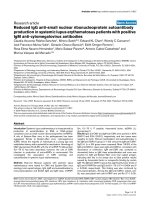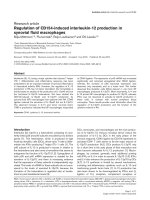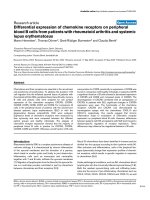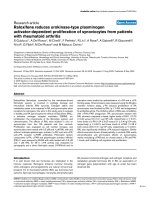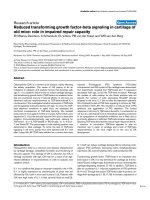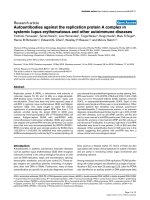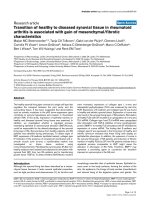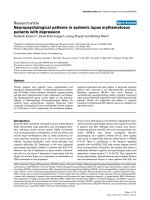Báo cáo y học: "Reduced IgG anti-small nuclear ribonucleoprotein autoantibody production in systemic lupus erythematosus patients with positive IgM anti-cytomegalovirus antibodies" pdf
Bạn đang xem bản rút gọn của tài liệu. Xem và tải ngay bản đầy đủ của tài liệu tại đây (1.19 MB, 12 trang )
Open Access
Available online />Page 1 of 12
(page number not for citation purposes)
Vol 11 No 1
Research article
Reduced IgG anti-small nuclear ribonucleoprotein autoantibody
production in systemic lupus erythematosus patients with positive
IgM anti-cytomegalovirus antibodies
Claudia Azucena Palafox Sánchez
1
, Minoru Satoh
2,3
, Edward KL Chan
4
, Wendy C Carcamo
4
,
José Francisco Muñoz Valle
1
, Gerardo Orozco Barocio
5
, Edith Oregon Romero
1
,
Rosa Elena Navarro Hernández
1
, Mario Salazar Páramo
6
, Antonio Cabral Castañeda
7
and
Mónica Vázquez del Mercado
1,8
1
Departamento de Biología Molecular y Genómica, Instituto de Investigación en Reumatología y del Sistema Músculo Esquelético (IIRSME), Centro
Universitario de Ciencias de la Salud, Universidad de Guadalajara, Sierra Mojada 950, Guadalajara, Jalisco, CP 44340, México
2
Division of Rheumatology and Clinical Immunology, Department of Medicine, University of Florida, P.O. Box 100221, Gainesville, FL 32610-0221,
USA
3
Department of Pathology, Immunology, and Laboratory Medicine, University of Florida, P.O. Box 100221, Gainesville, FL 32610-0221, USA
4
Department of Oral Biology, University of Florida, 1600 SW Archer Road, Gainesville, FL 32610-0424, USA
5
Departamento de Inmunología y Reumatología del Hospital General de Occidente, Secretaría de Salud Jalisco, Av. Zoquipan 1050, CP 45100,
Zapopan, Jalisco, México
6
División de Investigación, Hospital de Especialidades, CMNO, IMSS, and Deparamento de Fisiología, CUCS, Universidad de Guadalajara, Sierra
Mojada 950, CP 4430, Guadalajara, Jalisco, México
7
Departamento de Reumatología, Instituto Nacional en Ciencias Médicas y de la Nutrición Salvador Zubirán, Vasco de Quiroga 15, Tlalpan C.P.
14000, Mexico, DF, México
8
División de Medicina Interna, Departamento de Reumatología, Hospital Civil Juan I Menchaca, Salvador de Quevedo y Zubieta N° 750, CP 44340,
Guadalajara, Jalisco, México
Corresponding author: Minoru Satoh, Mónica Vázquez del Mercado,
Received: 1 Dec 2008 Revisions requested: 8 Jan 2009 Revisions received: 26 Jan 2009 Accepted: 20 Feb 2009 Published: 20 Feb 2009
Arthritis Research & Therapy 2009, 11:R27 (doi:10.1186/ar2621)
This article is online at: />© 2009 Palafox-Sánchez et al.; licensee BioMed Central Ltd.
This is an open access article distributed under the terms of the Creative Commons Attribution License ( />),
which permits unrestricted use, distribution, and reproduction in any medium, provided the original work is properly cited.
Abstract
Introduction Systemic lupus erythematosus is characterized by
production of autoantibodies to RNA or DNA–protein
complexes such as small nuclear ribonucleoproteins (snRNPs).
A role of Epstein–Barr virus in the pathogenesis has been
suggested. Similar to Epstein–Barr virus, cytomegalovirus
(CMV) infects the majority of individuals at a young age and
establishes latency with a potential for reactivation. Homology of
CMV glycoprotein B (UL55) with the U1snRNP-70 kDa protein
(U1–70 k) has been described; however, the role of CMV
infection in production of anti-snRNPs is controversial. We
investigated the association of CMV serology and
autoantibodies in systemic lupus erythematosus.
Methods Sixty-one Mexican patients with systemic lupus
erythematosus were tested for CMV and Epstein–Barr virus
serology (viral capsid antigen, IgG, IgM) and autoantibodies by
immunoprecipitation and ELISA (IgG and IgM class, U1RNP/
Sm, U1–70 k, P peptide, rheumatoid factor, dsDNA, β
2
-
glycoprotein I).
Results IgG anti-CMV and IgM anti-CMV were positive in 95%
(58/61) and 33% (20/61), respectively, and two cases were
negative for both. Clinical manifestation and autoantibodies in
the IgM anti-CMV(+) group (n = 20) versus the IgM anti-CMV(-
)IgG (+) (n = 39) group were compared. Most (19/20) of the
IgM anti-CMV(+) cases were IgG anti-CMV(+), consistent with
reactivation or reinfection. IgM anti-CMV was unrelated to
rheumatoid factor or IgM class autoantibodies and none was
positive for IgM anti-Epstein–Barr virus–viral capsid antigen,
indicating that this is not simply due to false positive results
caused by rheumatoid factor or nonspecific binding by certain
IgM. The IgM anti-CMV(+) group has significantly lower levels of
IgG anti-U1RNP/Sm and IgG anti-U1–70 k (P = 0.0004 and P
= 0.0046, respectively). This finding was also confirmed by
immunoprecipitation. Among the IgM anti-CMV(-) subset, anti-
Su was associated with anti-U1RNP and anti-Ro (P < 0.05).
BSA: bovine serum albumin; CMV: cytomegalovirus; dsDNA: double-stranded DNA; EBNA: EBV nuclear antigen; EBV: Epstein–Barr virus; ELISA:
enzyme-linked immunosorbent assay; IFN: interferon; I-IFN: type I interferon; IL: interleukin; mAb: monoclonal antibody; PCR: polymerase chain reac-
tion; RF: rheumatoid factor; SLE: systemic lupus erythematosus; snRNP: small nuclear ribonucleoprotein; TLR: Toll-like receptor; U1–70 k: U1snRNP-
70 kDa protein; VCA: viral capsid antigen.
Arthritis Research & Therapy Vol 11 No 1 Palafox Sánchez et al.
Page 2 of 12
(page number not for citation purposes)
High levels of IgG anti-CMV were associated with production of
lupus-related autoantibodies to RNA or DNA–protein complex
(P = 0.0077).
Conclusions Our findings suggest a potential role of CMV in
regulation of autoantibodies to snRNPs and may provide a
unique insight to understand the pathogenesis.
Introduction
Systemic lupus erythematosus (SLE) is an autoimmune dis-
ease of unknown etiology, characterized by production of
autoantibodies to cellular constituents – in particular, com-
plexes of dsDNA or RNA and proteins [1]. Various genetic and
environmental factors appear to be involved in the develop-
ment of SLE and the production of autoantibodies. Among the
environmental factors, a role of viruses in triggering SLE has
been investigated for many years [2,3]. However, traditional
approaches to identify unique viruses among SLE patients did
not produce consistent results, however, and recent evidence
suggests that common viruses such as Epstein–Barr virus
(EBV), cytomegalovirus (CMV), and parvovirus B19, to which
many individuals are exposed during life, may play a role in the
pathogenesis of SLE [2,3]. Increased prevalence of EBV
infection among SLE patients [4], homology of EBV nuclear
antigen (EBNA) 1 antigen and small nuclear ribonucleopro-
teins (snRNPs) [5], the pattern of epitope spreading consist-
ent with molecular mimicry mechanism of induction of
autoantibodies [6], and supporting evidence from animal mod-
els have all been described [5,7,8]. Similar to EBV, CMV
infects the majority of individuals at a young age and estab-
lishes lifelong latency with possible reactivation at various
times caused by a variety of triggers such as acute inflamma-
tion [9,10]. The reported prevalence of CMV infection based
on detection of anti-CMV antibodies or CMV-DNA by PCR
analysis of whole blood samples in SLE patients is from 60%
to 100% similar to the control population in most studies
[11,12]. A new infection or reactivation of CMV can mimic SLE
in some cases [12,13].
Previous studies have shown a homology of the U1snRNP-70
kDa protein (U1–70 k) and CMV envelope glycoprotein B
(UL55) and induction of anti-U1–70 k antibodies by glycopro-
tein B in a mouse model [14,15]. Association between autoan-
tibodies to the U1snRNPs and CMV infection in healthy
subjects and SLE patients has been reported [11]; however,
this was not confirmed in another study [16].
In the present study, we investigated whether the serological
status of CMV infection has an association with the production
of specific lupus autoantibodies – in particular, antibodies to
snRNPs.
Materials and methods
Patients
Sixty-one consecutive patients with SLE from the Department
of Rheumatology, Hospital General de Occidente, Zapopan,
Jalisco, Mexico were studied. All patients fulfilled the 1982
American College of Rheumatology SLE classification criteria
[17].
The Mexican Systemic Lupus Erythematosus Disease Activity
Index and the Systemic Lupus International Collaborating Clin-
ics/American Collage of Rheumatology Damage Indexes at
the beginning of the study were evaluated [18,19]. A complete
blood count, including the lymphocyte count and serum rheu-
matoid factor (RF) (CELL-DYN 3500R; Abbott Diagnostics
(Santa Clara, CA, USA), was determined in all subjects. Infor-
mation on treatment on the day of sampling, including use of
immunosuppressive drugs (azathioprine, methotrexate, and
cyclophosphamide), chloroquine, and a dose of steroid (pred-
nisone mg/day), was recorded.
The protocol was approved by the Institutional Review Board.
The present study meets and is in compliance with all ethical
standards in medicine, and written informed consent was
obtained from all patients according to the Declaration of Hel-
sinki.
Viral serology
IgG and IgM antibodies against CMV were measured using a
microparticle enzyme immunoassay kit (Abbott Laboratories,
Abbott Park, IL, USA) following the manufacturer's instruc-
tions. The specimens with index values ≥ 0.5 units/ml and ≥ 15
units/ml, respectively, for IgM and IgG antibodies to CMV,
were considered positive. IgG and IgM antibodies to EBV viral
capsid antigen (VCA) were measured by ELISA (Biotech
Atlantic Inc., Eatontown, NJ, USA).
Anti-U1RNP/Sm antigen-capture ELISA
Anti-U1RNP/Sm antigen-capture ELISA was performed
essentially as described for other human autoantibody sys-
tems [20]. Briefly, microtiter plates (Immobilizer Amino™; Nal-
gene Nunc [Rochester, NY, USA]) were coated with 3 μg/ml
mouse mAb 2.73 (IgG
2a
, anti-U1–70 k) [21] overnight and
were blocked with 0.5% BSA NET/NP40 (150 mM NaCl, 2
mM ethylenediamine tetraacetic acid, 50 mM Tris–HCl, pH
7.5, 0.3% Nonidet-P40). The left half of the plate was incu-
bated with K562 cell lysate (50 μl/well, 4 × 10
7
/ml) and the
right half was incubated with the blocking buffer. After wash-
ing the plate with Tris-buffered saline/Tween20 (20 mM Tris–
HCl, pH 7.5, 150 mM NaCl, 0.1% Tween20) three times and
0.5 M NaCl/NET/NP40 (500 mM NaCl, 2 mM ethylenedi-
amine tetraacetic acid, 50 mM Tris–HCl, pH 7.5, 0.3% Noni-
det-P40) three times, an identical set of samples and serially
diluted standard serum (1:500 to serial 1:5 dilutions) were
added to the left half and the right half (control for reactivity
Available online />Page 3 of 12
(page number not for citation purposes)
against mouse IgG) of the plate. Serum samples were tested
at 1:500 and 1:2,500 dilutions, and data from the latter were
used for the analysis. Plates were washed with Tris-buffered
saline/Tween20, incubated with alkaline phosphatase-conju-
gated mouse mAbs to human IgG (1:1,000 dilution; Sigma
[St. Louis, MO, USA]) and developed. The 405 nm optical
density of wells were converted into units based on the stand-
ard curve using SoftMax Pro 4.3 software (Molecular Devices,
Sunnyvale, CA, USA) and the units of the corresponding right
half (without U1RNP/Sm antigens) were subtracted from
those of the left half (with antigens) [20].
ELISA for antibodies to P peptide, dsDNA, mouse IgG
(rheumatoid factor), U1–70 k, and β
2
-glycoprotein I
Microtiter plates (Immobilizer Amino™; Nunc) were incubated
with 1 to 3 μg/ml appropriate antigen, and ELISA was per-
formed as described previously using 1:500 (for all IgG class
antibodies), 1:2,500 (IgG anti-U1–70 k ELISA) or 1:100 (for
all IgM class antibodies) diluted sera. Optical densities were
converted into units as described using appropriate standard
[20]. P peptide was the COOH-terminal 22 amino acids of
human P0 protein [22]. Mouse IgG was a mixture of mouse
IgG
1
and IgG
2a
myeloma proteins (Southern Biotechnology,
Birmingham, AL, USA). dsDNA was purified using S1 nucle-
ase and the ELISA was performed as described previously
[20]. β
2
-glycoprotein I was a gift from Dr Jyunichi Kaburaki
(Tokyo Electric Company Hospital, Tokyo, Japan).
U1–70 k recombinant protein was a 184 amino acid fragment
spanning amino acids 240 to 423, a major human B-cell
epitope that contains the arginine/serine-rich region [23]. The
full-length cDNA for U1–70 k protein was kindly provided by
Dr Ger JM Pruijn (Department of Biochemistry, University of
Nijmegen, The Netherlands). The cDNA fragment was cloned
by PCR amplification and subcloned into pDONR transition
vector (Invitrogen, Carlsbad, CA, USA) and then into
pDEST17 vector. The recombinant protein was expressed in
Escherichia coli and purified via nickel affinity column.
Screening of autoantibodies in human sera by
immunoprecipitation
Immunoprecipitation using
35
S-methionine-labeled K562 cell
extract was performed using 8 μl sera as described elsewhere
[21]. Specificities were determined using previously
described reference sera. Positive anti-U1RNP was defined
based on the presence of the set of U1RNP proteins (A, B'/B,
C, D1/D2/D3, E/F, and G). Since autoantibodies to U5RNP
without anti-Sm are very rare [24], immunoprecipitation of the
characteristic U5RNP 200 kDa proteins was used to define
anti-Sm (which immunoprecipitates U2, U4–U6, and U5 in
addition to U1RNP) [21].
Statistical analysis
All statistical analysis was performed using Prism 5.0 for Mac-
intosh (GraphPad Software, Inc., San Diego, CA, USA).
Fisher's exact test and the Mann–Whitney test were used to
analyze the prevalence and the levels, respectively, of autoan-
tibodies and other data.
Results
Cytomegalovirus serology
The prevalence of positive IgG anti-CMV antibodies and posi-
tive IgM anti-CMV antibodies in the SLE population was 95%
(58/61) and 33% (20/61), respectively. Two subjects, nega-
tive for both IgG and IgM antibodies, were excluded from the
following analysis. The rest of the SLE patients were divided
into two groups; 20 subjects who were anti-CMV IgM(+) [19
IgG(+) and one IgG(-)], and 39 subjects who were anti-CMV
IgM(-)IgG(+) (Table 1).
Demographic and clinical characteristics
The demographic and clinical characteristics of the subjects
comparing the IgM anti-CMV(+) group versus the IgM anti-
CMV(-)IgG(+) group are summarized in Table 1. Of these 59
patients, 56 were female and three were male with mean age
of 36.7 ± 14.1 years. Age at onset was younger in the IgM
anti-CMV(+) group (P < 0.05 by Mann–Whitney test) but oth-
erwise no significant differences were observed between the
groups. The percentage of patients on immunosuppressive
drugs (azathioprine, methotrexate, and cyclophosphamide), on
chloroquine, or on steroids, and a dose of steroids (pred-
nisone mg/day) also was not significantly different between
groups.
IgM anti-CMV antibodies are not due to rheumatoid
factor or nonspecific reactivity of certain IgM antibodies
IgM anti-CMV can become positive in some cases of reactiva-
tion or reinfection of CMV [9,10]. The prevalence of IgM anti-
CMV among SLE patients in the present study was much
higher (33%) than in the general population, similar to some
previous studies that also reported high prevalence of IgM
anti-CMV among SLE patients [25-27]. False positive results
for IgM anti-CMV due to RF or nonspecific binding of certain
IgM antibodies, however, have also been reported [25].
The levels of RF and other control IgM autoantibodies were
therefore compared between IgM anti-CMV(+) patients versus
IgM anti-CMV(-) patients (Figure 1) to examine whether RF or
nonspecific reaction of IgM in certain patients can explain IgM
anti-CMV in our cohort. Levels of RF by laser nephelometry
and of IgM and IgG RF by ELISA were not higher in the IgM
anti-CMV(+) group versus the IgM anti-CMV(-) group, indicat-
ing that the positive IgM anti-CMV is not simply due to RF in
this group. Furthermore, levels of IgM antibodies to U1–70 k
or to β
2
-glycoprotein I (Figure 1), dsDNA, P peptide, U1RNP/
Sm, and chromatin (data not shown) were not higher in the
IgM anti-CMV(+) group. In addition, all 20 IgM anti-CMV(+)
patients were IgM anti-EBV viral capsid antigen-negative, indi-
cating that high levels of IgM anti-CMV in this group are not
due to nonspecific high reactivity of IgM antibodies in this
Arthritis Research & Therapy Vol 11 No 1 Palafox Sánchez et al.
Page 4 of 12
(page number not for citation purposes)
group of patients. The IgM anti-CMV(+) group of patients was
therefore considered to mainly reflect the reactivation or rein-
fection of CMV, and possibly some of the patients may be at a
late stage of primary infection [one subject was anti-CMV
IgM(+)IgG(-)].
Prevalence and levels of autoantibodies in anti-CMV
IgM(+) versus anti-CMV IgM(-)IgG(+) groups
The prevalence and levels of autoantibodies in the IgM anti-
CMV(+) group versus the IgM anti-CMV(-)IgG anti-CMV(+)
group were compared by immunoprecipitation and ELISA to
evaluate the association of the CMV serology and autoanti-
bodies. The prevalence of autoantibodies by immunoprecipita-
tion is summarized in Table 2. In general, the prevalence of
autoantibodies was similar except that anti-Sm was found only
in the IgM anti-CMV(-) group (15%, 6/39) and none in the IgM
anti-CMV(+) group (0/20, not significant). The prevalence of
anti-Sm among the anti-U1snRNP-positive subset, however,
was significantly lower in the IgM anti-CMV(+) group versus
the IgM anti-CMV(-)IgG anti-CMV(+) group (0% vs. 50%, P =
0.04 by Fisher's exact test). Furthermore, the prevalence of
high levels (>25 units) of antibodies to U1RNP/Sm by ELISA
was significantly lower in the anti-CMV IgM(+) versus anti-
Table 1
Demographic and clinical characteristics in systemic lupus erythematosus patients with IgM anti-CMV(+) versus IgM anti-CMV(-)
All patients IgM anti-CMV(+) patients IgM anti-CMV(-)
IgG anti-CMV(+) patients
n 59 20
a
39
Age (years) 36.7 ± 14.1 (13 to 72) 34.3 ± 15.1 (14 to 72) 37.9 ± 13.6 (13 to 64)
Sex (female/male) 56/3 18/2 38/1
Disease status
Disease duration (years) 7.4 ± 6.4 (0.1 to 36) 9.4 ± 8.0 (2 to 36) 6.5 ± 5.3 (0.1 to 23)
Age at diagnosis (years) 29.2 ± 12.1 (7 to 57) 24.9 ± 10.9* (7 to 57) 31.5 ± 12.3* (12 to 57)
Clinical assessment
Mexican SLEDAI 2.88 ± 2.97 (0.0 to 12) 3.30 ± 3.26 (0.0 to 10) 2.67 ± 2.83 (0.0 to 12)
SLICC 0.76 ± 1.75 (0.0 to 12) 1.11 ± 2.75 (0.0 to 12) 0.59 ± 0.97 (0.0 to 3)
Laboratory data
Rheumatoid factor (IU/ml) 18.2 ± 20.9 (2 to 108) 21.3 ± 29.0 (2 to 108) 16.7 ± 15.5 (3 to 60)
Soluble IL-10 (pg/ml) 27.9 ± 54.8 (9.31 to 422) 39.4 ± 90.5 (11.7 to 422) 22.0 ± 19.4 (9.3 to 126.7)
IgG CMV (U) 233.7 ± 46.3 (3.5 to 250) 233.6 ± 55.3 (3.5 to 250) 233.8 ± 41.8 (70 to 250)
White blood cells (/μl) 5,782 ± 2,008 (2,870 to 12,100) 5,413 ± 1,713 (2,900 to 8,700) 5,962 ± 2,135 (2,870 to 12,100)
Lymphocyte (/μl) 1493 ± 688 (154 to 3,400) 1450 ± 676 (154 to 2,890) 1515 ± 702 (269 to 3,400)
Platelet (× 10
3
/μl) 273.8 ± 63.9 (137 to 445) 262.8 ± 81.7 (137 to 445) 279.2 ± 53.7 (167 to 385)
Treatment
Azathioprine (%) 59 47 64
Methotrexate (%) 21 16 23
Cyclophosphamide (%) 5 5 5
Immunosuppressive therapy
b
(%) 79 63 87
Chloroquine (%) 52 53 51
On steroid (%) 57 68 51
Steroid dose (prednisone mg/day) 4.7 ± 6.1 5.9 ± 5.9 4.1 ± 6.2
Prednisone ≥ 10 mg/day (%) 17 26 13
Data presented as the mean ± standard deviation (minimum to maximum). All values were compared between the IgM anti-CMV(+) group and the
IgM anti-CMV(-)IgG(+) group using the Mann–Whitney test (values) or Fisher's exact test (%). P values were not significant (P > 0.05) except for
age at diagnosis (*P = 0.048). CMV, cytomegalovirus; SLEDAI, Systemic Lupus Erythematosus Disease Activity Index; SLICC, Systemic Lupus
International Collaborating Clinics.
a
Information for treatment was available in 19 patients in this group.
b
Azathioprine, methotrexate, or
cyclophosphamide.
Available online />Page 5 of 12
(page number not for citation purposes)
CMV IgM(-)IgG(+) group (0% vs. 28%, P = 0.0106 by
Fisher's exact test).
To confirm the difference in levels of autoantibodies to
snRNPs, anti-snRNP immunoprecipitation-positive samples
(IgM anti-CMV(+) group, n = 7; IgM anti-CMV(-)IgG anti-
CMV(+) group, n = 12) were tested by anti-U1RNP/Sm anti-
gen-capture ELISA and anti-U1–70 k ELISA (Figure 2a). The
anti-CMV IgM(+) group has significantly lower levels of IgG
anti-U1RNP/Sm (P = 0.0004) and of IgG anti-U1–70 k (P =
0.0046) versus the IgM anti-CMV(-)IgG(+) group. Levels of
IgM anti-U1RNP/Sm (data not shown) or IgM anti-U1–70 k
Figure 1
Serum rheumatoid factor and other IgM class antibodies in IgM anti-CMV(+) versus anti-CMV(-) patientsSerum rheumatoid factor and other IgM class antibodies in IgM anti-CMV(+) versus anti-CMV(-) patients. IgM anti-cytomegalovirus (CMV) (micropar-
ticle enzyme immunoassay), rheumatoid factor (RF) (laser nephelometry), IgM or IgG antibodies to mouse IgG, IgM anti-U1snRNP-70 kDa protein
(anti-U1–70 k) and anti-β
2
-glycoprotein I (anti-β2GPI) (ELISA) were performed as described in Materials and methods. Serum dilution for ELISA was
1:100 for IgM class and 1:500 for IgG anti-mouse IgG.
Arthritis Research & Therapy Vol 11 No 1 Palafox Sánchez et al.
Page 6 of 12
(page number not for citation purposes)
(Figure 1, bottom left) were not significantly different between
groups, indicating that this is a phenomenon specific for IgG
class antibodies. Furthermore, this is specific for IgG anti-
U1RNP/Sm and U1–70 k and is not a general phenomenon of
IgG-class autoantibodies, since the levels of IgG anti-P pep-
tide, dsDNA, β
2
-glycoprotein I (Figure 2b), or IgG RF were
similar between groups (Figure 1).
Levels of anti-snRNPs were also compared by immunoprecip-
itation (Figure 3). Although all components of U1snRNPs (A,
B'/B, C, D1/D2/D3, E/F, and G) were seen by all seven anti-
snRNP-positive sera in the IgM anti-CMV(+) group, signals
were much weaker than those by sera from the anti-CMV IgM(-
)IgG (+) group, consistent with the ELISA results (Figure 2a).
Signals of other autoantibodies by immunoprecipitation –
including anti-Ro, ribosomal P, RNA helicase A, and Su – were
not clearly different in the IgM anti-CMV(+) group versus the
IgM anti-CMV(-)IgG(+) group, consistent with the ELISA data.
All these data indicate that the IgM anti-CMV(+) group has
lower levels of IgG autoantibodies specifically for anti-U1RNP/
Sm and U1–70 k; however, no difference was observed in
IgM-class autoantibodies for these specificities or other
autoantibodies in the IgG or IgM class.
Relationship of different autoantibodies in the anti-CMV
IgM(+) and ant-CMV IgM(-)IgG(+) groups
Although the prevalence of various autoantibodies in anti-CMV
IgM(+) SLE versus anti-CMV IgM(-)IgG(+) SLE was similar
(Table 2), it is possible that the pattern of coexistence of
autoantibodies is different. The prevalence of various autoanti-
bodies in anti-U1RNP, Ro, or Su positive versus negative sub-
sets and the presence of IgM anti-CMV antibodies were
therefore analyzed. Anti-Su antibodies appeared to frequently
coexist with anti-U1RNP or Ro in the anti-CMV IgM(-)IgG(+)
group (P = 0.0141 and P = 0.0631, respectively) but not in
the anti-CMV IgM(+) group (Table 3). When similar analysis
was performed for anti-U1RNP(+) versus anti-U1RNP(-), anti-
Su was found in 50% (6/12) of the former versus 11% (3/27)
of the latter (P = 0.0141) in the anti-CMV IgM(-)IgG(+) subset.
Similarly, anti-Su appeared to be more frequent for anti-Ro(+)
than anti-Ro(-), although it did not reach statistical significance
(40% vs. 13%, P = 0.0631), in the anti-CMV IgM(-)IgG(+)
group. Anti-Su and anti-U1RNP or anti-Ro may therefore coex-
ist frequently only in the anti-CMV IgM(-)IgG(+) group of
patients.
Levels of IgG anti-CMV antibodies and presence of
autoantibodies
Seventy-seven percent (47/61) of cases had very high levels
(>250 units) of IgG anti-CMV; 89% (54/61) of cases had IgG
anti-CMV > 200 units, while only seven cases had IgG anti-
CMV < 200 units. The prevalence of autoantibodies by immu-
noprecipitation was compared between these two groups
(Table 4). The latter group (IgG anti-CMV < 200 units) had
only one each of anti-Ro and anti-Su, and none in this group
had anti-U1RNP (0% vs. 35%, P = 0.0875), Sm, ribosomal P,
RNA helicase A, La, and Ku. Only 28% in this IgG anti-CMV <
200 units group had any of the above listed autoantibodies
versus 81% (44/54) in the IgG anti-CMV > 200 units group
(P = 0.0077 by Fisher's exact test), indicating that the produc-
tion of IgG lupus-related autoantibodies to RNA or dsDNA–
protein complexes is generally more frequent in patients with
high levels of IgG anti-CMV.
Table 2
Frequency of autoantibodies in IgM anti-cytomegalovirus (CMV)(+) patients versus IgM anti-CMV(-) patients
Anti-CMV IgM(+) patients Anti-CMV IgM(-)IgG(+) patients
n 20 39
U1RNP 37% (7/20) 31% (12/39)
Sm 0% (0/20) 15% (6/39)
Sm/U1RNP 0% (0/7) 50% (6/12)*
Ribosomal P 5% (1/20) 10% (4/39)
RNA helicase A 15% (3/20) 26% (10/39)
Ro 35% (7/20) 38% (15/39)
La 15% (3/20) 8% (3/39)
Ku 10% (2/20) 5% (2/39)
Su 30% (6/20) 23% (9/39)
RNA polymerase II 10% (2/20) 8% (3/39)
U1RNP/Sm ELISA > 25 units 0% (0/20) 28% (11/39)
†
Sm/U1RNP, prevalence of anti-Sm among anti-U1RNP-positive patients. *P = 0.04.
†
P = 0.0106.
Available online />Page 7 of 12
(page number not for citation purposes)
Figure 2
IgG autoantibodies by ELISA in IgM anti-CMV(+) versus IgM anti-CMV(-) patientsIgG autoantibodies by ELISA in IgM anti-CMV(+) versus IgM anti-CMV(-) patients. (a) IgG anti-U1RNP/Sm and IgG anti-U1snRNP-70 kDa protein
(anti-U1–70 k) by ELISA. Anti-small nuclear ribonucleoprotein (Anti-snRNP) immunoprecipitation-positive sera (1:2,500 dilution, n = 7 for the IgM
anti-cytomegalovirus (CMV)(+) group and n = 12 for the anti-CMV IgM(-)IgG(+) group) were tested for anti-U1RNP/Sm and U1–70 k antibodies by
ELISA. (b) IgG anti-U1–70 k, P peptide, dsDNA, and anti-β
2
-glycoprotein I (anti-β2GPI) by ELISA. ELISAs were performed as described in Materials
and methods using 1:500 diluted sera. For anti-U1RNP/Sm and U1–70 k, data from 1:2,500 diluted sera are shown.
Arthritis Research & Therapy Vol 11 No 1 Palafox Sánchez et al.
Page 8 of 12
(page number not for citation purposes)
Discussion
SLE and CMV infection share common manifestations and a
new infection or reactivation of CMV can mimic SLE [28].
CMV may also be considered responsible for flare or develop-
ment of SLE in some cases [13,28-31]. Primary infection is
characterized by positive IgM anti-CMV and negative IgG anti-
CMV, followed by seroconversion to positive IgG anti-CMV;
however, positive IgM anti-CMV is also seen frequently in
patients with reactivation or reinfection of CMV [9,10,32].
CMV infection is a common complication in the immunocom-
promised host and in transplant patients under immunosup-
pressive therapy [10]. Whether reactivation of CMV is also
common in SLE is controversial [25-27,33], because of a lack
of standardized methods leading to inconsistency in the IgM
anti-CMV assay and the PCR assay to detect CMV DNA.
In the present study, 95% of SLE patients were IgG anti-
CMV(+). IgG anti-CMV detected at a high percentage (60%
to 100%) in SLE patients was similar to the control population
in most studies [11,25-27,34,35], although a few studies have
reported a higher percentage of IgG anti-CMV in SLE patients
versus control individuals [12,36].
The reported prevalence of IgM anti-CMV varies significantly
from 5% to 45% [12,25-27,34], and was 33% in the present
study. False positive results for IgM anti-CMV due to RF and
Figure 3
Autoantibodies to small nuclear ribonucleoproteins by immunoprecipitationAutoantibodies to small nuclear ribonucleoproteins by immunoprecipitation. Immunoprecipitation by anti-small nuclear ribonucleoprotein immunopre-
cipitation-positive sera (lanes 1 to 7, all seven sera from the anti-cytomegalovirus (CMV) IgM(+) group; lanes 8 to 13, six randomly selected sera
from the 12 in the anti-CMV IgM(-)IgG(+) group) and a normal human serum (NHS) are shown. Positions of UsnRNP components A, B'/B, C, D1/
D2/D3, E/F, G, U5–200 k doublet, and 60 k Ro, and molecular weights (kDa) are indicated. White arrowheads, U5–200 k.
Table 3
Association of anti-Su and other autoantibodies
Anti-CMV IgM(+) patients Anti-CMV IgM(-)IgG(+) patients
Su-positive Su-negative Su-positive Su-negative
n 6149 30
U1RNP 17% (1/6) 43% (6/14) 67% (6/9)* 20% (6/30)*
Sm 0% (0/6) 0% (0/14) 33% (3/9) 10% (3/30)
Ribosomal P 17% (1/6) 7% (1/14) 0% (0/9) 13% (4/30)
RNA helicase A 17% (1/6) 14% (2/14) 33% (3/9) 23% (7/30)
Ro 33% (2/6) 36% (5/14) 67% (6/9)
†
30% (9/30)
2
La 0% (0/6) 21% (3/14) 11% (1/9) 7% (2/30)
CMV, cytomegalovirus. *P = 0.0141,
†
P = 0.0631.
Available online />Page 9 of 12
(page number not for citation purposes)
other reasons have been reported [25-27]. In one study that
reported IgM anti-CMV in 14% of SLE cases, 3/12 were con-
sidered an artifact after a RF neutralization assay [27]. Other
studies interpreted IgM anti-CMV as false positive results
based on negative PCR [25,26]. In contrast, one study
detected CMV DNA by PCR in whole blood from 100% of
SLE patients versus 72% in controls (P = 0.02) [12], suggest-
ing a significant difference in sensitivity of the PCR assay. A
recent study using immunostaining of CMV pp65 in peripheral
blood leukocytes has suggested that reactivation of CMV is
common among IgM anti-CMV(+) SLE patients under inten-
sive immunosuppressive therapy [33]. The RF neutralization
assay or PCR to detect CMV DNA was not performed in the
present study; however, IgM anti-CMV was not associated
with RF by laser nephelometry or ELISA (Figure 1), suggesting
it was not directly due to RF. Furthermore, none of the IgM
anti-CMV(+) group was positive for IgM antibodies to EBV–
viral capsid antigen (data not shown). Also, the IgM anti-
CMV(+) group did not have higher levels of IgM class autoan-
tibodies to snRNPs, U1–70 k, dsDNA, chromatin, β
2
-glyco-
protein I, or P peptide (Figure 1), indicating that IgM anti-CMV
was not due to nonspecific IgM reactions in these patients.
The majority of IgM anti-CMV therefore appears to be specific
for the CMV assay and may be considered a reflection of reac-
tivation or reinfection of CMV since all except one case had
positive IgG anti-CMV.
Autoantibodies to snRNPs are found in ~40% of SLE patients,
in 100% of mixed connective tissue disease and at lower prev-
alence in other systemic rheumatic diseases [37]. The autoim-
mune response to U1–70 k is considered characteristic of
mixed connective tissue disease and an early autoimmune
response in anti-U1RNP-positive patients [37,38]. CMV glyc-
oprotein B/UL55 has a homology with the U1–70 k protein
and can induce anti-U1–70 k antibodies in a mouse model
[14,15]. Human vaccination of a live attenuated Towne vac-
cine, a recombinant CMV glycoprotein B vaccine or a glyco-
protein B canarypox vectored vaccine (ALVAC-CMVgB)
administered to CMV-seronegative subjects, however, did not
induce antinuclear or anti-U1RNP antibodies [16,39]. Reports
on the association between autoantibodies to the U1snRNPs
and CMV infection in healthy subjects and SLE patients were
inconsistent [11,16]. The study reporting a lack of association
between anti-snRNP autoantibody production and CMV infec-
tion appears credible since they found no anti-U1RNP or anti-
Sm positives among healthy individuals and only 2/80 were
positive in the anti-U1–70 k ELISA [16]. The other study
reported an increased prevalence of CMV infection among
healthy individuals with anti-snRNP autoantibodies, however,
with unusually high optical densities in the anti-U1RNP ELISA
among healthy individuals (mean optical density 0.643 in the
CMV(+) group versus 0.406 in the CMV(-) group) and a high
prevalence of positive anti-U1RNP among healthy individuals
(84% in the CMV(+) group and 24% in the CMV(-) group)
[11], making the interpretation of this study difficult. Since we
have only two CMV-seronegative SLE patients, our data can-
not be compared with these studies.
In the present study, IgM CMV(+) patients had lower levels of
anti-U1RNP/Sm and anti-U1–70 k autoantibodies versus anti-
CMV IgM(-)IgG(+) patients (Figures 2 and 3). Anti-snRNPs
and other lupus-related autoantibodies were more frequent in
patients with high levels of IgG anti-CMV (Table 4). These
observations are consistent with the role of immune response
to CMV in lupus autoantibody production.
The mechanisms of the negative association of IgM anti-CMV
and anti-snRNP autoantibodies are unclear. This does not
appear to result from a difference in treatment between groups
(Table 1); immunosuppressive treatment was not more com-
Table 4
Frequency of autoantibodies in low IgG anti-cytomegalovirus (CMV) patients versus high IgG anti-CMV patients
Low IgG anti-CMV (<200 units) High IgG anti-CMV (>200 units)
n 754
U1RNP 0% (0/7) 35% (19/54)*
Sm 0% (0/7) 11% (6/54)
Ribosomal P 0% (0/7) 9% (5/54)
RNA helicase A 0% (0/7) 24% (13/54)
Ro 14% (1/7) 41% (22/54)
La 0% (0/7) 11% (6/54)
Ku 0% (0/7) 7% (4/54)
Su 14% (1/7) 28% (15/54)
Any of the above 28% (2/7) 81% (44/54)
†
*P = 0.0875,
†
P = 0.0077 by Fisher's exact test.
Arthritis Research & Therapy Vol 11 No 1 Palafox Sánchez et al.
Page 10 of 12
(page number not for citation purposes)
mon in patients of the IgM anti-CMV(+) group versus those of
the IgM anti-CMV(-) group. Also, the reduced levels of anti-
bodies in the former group were specific for IgG anti-
U1snRNPs and anti-U1–70 k and were not observed in other
specificities (Figures 1 and 2). The difference in IgG anti-
snRNPs or U1–70 k units that reflect the amount of antibodies
in the sera was 30-fold to 80-fold (Figure 2). All of these data
suggest that the difference in levels of IgG anti-U1snRNPs
and U1–70 k antibodies between groups cannot be a simple
reflection of different total IgG levels. It is tempting to specu-
late that reactivated/reinfected CMV or its products play a role
in downregulating anti-snRNP autoantibodies. This may sound
strange since most previous studies were focused on the role
of viruses in inducing or enhancing autoantibodies in SLE [3];
however, viruses have various mechanisms to inhibit host
immune function in order to survive and escape from elimina-
tion by the host immune system. In fact, viral anti-inflammatory
and immune-modulating proteins have been applied to treat
inflammatory and immune disorders [40]. There are several
possible mechanisms that may explain inhibition of anti-snRNP
autoantibody production by CMV.
First of all, U1RNA can stimulate type I interferon (I-IFN) pro-
duction via TLR7 [41] and anti-snRNP autoantibody produc-
tion is TLR7 and I-IFN dependent [42,43]. The antagonistic
effects of TLR7 and TLR9 stimulation reported recently
[44,45] are of particular interest in speculating that the binding
of CMV DNA to TLR9 may interfere in the TLR7-dependent
anti-snRNP autoantibody production.
A second consideration is that CMV has various mechanisms
to escape from the attack by a host immune system [46-48],
including suppression of I-IFN production [49]. CMV IL-10 or
host IL-10 induced by reactivated or reinfected CMV may shift
the cytokine balance towards T helper type 2 and show antag-
onistic effects on IFNγ-dependent production of anti-snRNP
autoantibodies [50].
Preferential effects on anti-snRNP autoantibody production
are another interesting point that cannot be explained by avail-
able information. This situation may not be so unusual, how-
ever, considering that the same environmental or endogenous
factor can exhibit different effects on different specificities of
lupus autoantibodies [51-54]. Any immunological effect of
CMV or a combination of the immunological effects of CMV
[49] can shift an environment to one unfavorable for produc-
tion of anti-snRNPs, leading to reduced levels of anti-snRNP
autoantibodies in SLE patients with reactivated CMV.
On the other hand, a strong immune response against CMV
proteins may induce or enhance anti-snRNP autoimmune
response via molecular mimicry, as shown in mouse models
[14,15]. Depending on the balance of immune response to
CMV versus the immunosuppressive effects of CMV, there-
fore, in vivo biological effects of CMV may work towards
enhancing or suppressing immune and autoimmune
responses. Positive association of high levels of IgG anti-CMV
and IgG lupus autoantibodies and negative association of IgM
anti-CMV (reflecting reactivation of CMV) and IgG anti-
snRNPs antibodies may be consistent with this possibility.
Coexistence of anti-Su with anti-snRNPs or anti-Ro was also
an interesting finding. Like the U1RNA component of snRNPs,
the Y RNAs of Ro antigens induce I-IFN via TLR7 stimulation
[41]. Anti-snRNPs and anti-Ro are both associated with pro-
duction of high levels of I-IFN in SLE [55]. The Su antigen was
recently identified as Ago2, a component of RNA interference
machinery enriched in GW/P bodies containing macromo-
lecular complex with mRNA and microRNA [56]. Anti-Su pro-
duction in an animal model is also TLR7 dependent, similar to
anti-snRNP production [43]. Three autoantibodies that appear
to coexist often in the anti-CMV IgM(-)IgG(+) subset of SLE
cases (Table 3) are therefore all involved in TLR7 stimulation
and/or I-IFN production, suggesting common mechanisms in
production.
Conclusion
Our findings suggest the potential role of CMV in regulation of
autoantibodies to snRNPs and may provide a unique insight to
understanding the mechanisms of production of lupus autoan-
tibodies. Longitudinal studies carefully monitoring the kinetics
and serology of CMV and autoantibodies will be necessary to
understand the role of CMV in lupus autoantibody production.
Competing interests
The authors declare that they have no competing interests.
Authors' contributions
CAPS and MS helped to design the study, perform experi-
ments, and write the manuscript. EKLC designed and
expressed recombinant proteins and helped write the manu-
script. WCC expressed and purified recombinant proteins.
JFMV, GOB, EOR, RENH, MSP and ACC helped to design
and perform experiments. MVDM designed the study, per-
formed experiments, and wrote the manuscript. All authors
read and approved the final manuscript.
Acknowledgements
The authors thank Dr Jyunichi Kaburaki (Tokyo Electric Company Hospi-
tal, Tokyo, Japan) for his gift of β
2
-glycoprotein I, Dr Ger JM Pruijn
(Department of Biochemistry, University of Nijmegen, The Netherlands)
for providing the full-length U1–70 k protein cDNA, and Dr Pui Y Lee
(University of Florida, USA) for his discussion on Toll-like receptors. The
present study was supported by CONACyT-SEP Ciencia Bàsica grant
51353, Universidad de Guadalajara agreement 25473 to MVDM and a
grant from Lupus Foundation of America, Inc. to MS. EKLC is supported
in part by NIH grant AI47859.
References
1. Reeves WH, Narain S, Satoh M: Autoantibodies in systemic
lupus erythematosus. In Arthritis and Allied Conditions A Text-
book of Rheumatology 15th edition. Edited by: Koopman WJ,
Available online />Page 11 of 12
(page number not for citation purposes)
Moreland LW. Philadelphia: Lippincott Williams and Wilkins;
2005:1497-1521.
2. Denman AM: Systemic lupus erythematosus – is a viral aetiol-
ogy a credible hypothesis? J Infect 2000, 40:229-233.
3. Barzilai O, Ram M, Shoenfeld Y: Viral infection can induce the
production of autoantibodies. Curr Opin Rheumatol 2007,
19:636-643.
4. James JA, Kaufman KM, Farris AD, Taylor-Albert E, Lehman TJ, Har-
ley JB: An increased prevalence of Epstein–Barr virus infection
in young patients suggests a possible etiology for systemic
lupus erythematosus. J Clin Invest 1997, 100:3019-3026.
5. Poole BD, Scofield RH, Harley JB, James JA: Epstein–Barr virus
and molecular mimicry in systemic lupus erythematosus.
Autoimmunity 2006, 39:63-70.
6. Arbuckle MR, Reichlin M, Harley JB, James JA: Shared early
autoantibody recognition events in the development of anti-
Sm B/B' in human lupus. Scand J Immunol 1999, 50:447-455.
7. James JA, Gross T, Scofield RH, Harley JB: Immunoglobulin
epitope spreading and autoimmune disease after peptide
immunization: Sm B/B'-derived PPPGMRPP and PPPGIRGP
induce spliceosomme autoimmunity. J Exp Med 1995,
181:453-461.
8. Poole BD, Gross T, Maier S, Harley JB, James JA: Lupus-like
autoantibody development in rabbits and mice after immuni-
zation with EBNA-1 fragments. J Autoimmun 2008,
31:362-371.
9. St George K, Rowe DT, Rinaldo CR Jr: Cytomegalovirus, vari-
cella-zoster virus, and Epstein–Barr virus. In Clinical Virology
Manual 3rd edition. Edited by: Spector S, Hodinka RL, Young SA.
Washington, DC: ASM Press; 2000:410-449.
10. Britt W: Manifestations of human cytomegalovirus infection:
proposed mechanisms of acute and chronic disease. Curr Top
Microbiol Immunol 2008, 325:417-470.
11. Newkirk MM, van Venrooij WJ, Marshall GS: Autoimmune
response to U1 small nuclear ribonucleoprotein (U1 snRNP)
associated with cytomegalovirus infection. Arthritis Res 2001,
3:253-258.
12. Hrycek A, Kusmierz D, Mazurek U, Wilczok T: Human cytomega-
lovirus in patients with systemic lupus erythematosus.
Autoimmunity 2005,
38:487-491.
13. Hayashi T, Lee S, Ogasawara H, Sekigawa I, Iida N, Tomino Y,
Hashimoto H, Hirose S: Exacerbation of systemic lupus ery-
thematosus related to cytomegalovirus infection. Lupus 1998,
7:561-564.
14. Curtis HA, Singh T, Newkirk MM: Recombinant cytomegalovirus
glycoprotein gB (UL55) induces an autoantibody response to
the U1–70 kDa small nuclear ribonucleoprotein. Eur J Immunol
1999, 29:3643-3653.
15. Lipes J, Skamene E, Newkirk MM: The genotype of mice influ-
ences the autoimmune response to spliceosome proteins
induced by cytomegalovirus gB immunization. Clin Exp Immu-
nol 2002, 129:19-26.
16. Marshall BC, McPherson RA, Greidinger E, Hoffman R, Adler SP:
Lack of autoantibody production associated with cytomegalo-
virus infection. Arthritis Res 2002, 4:R6.
17. Tan EM, Cohen AS, Fries JF, Masi AT, McShane DJ, Rothfield NF,
Schaller JG, Talal N, Winchester RJ: The 1982 revised criteria for
the classification of systemic lupus erythematosus. Arthritis
Rheum 1982, 25:1271-1277.
18. Guzman J, Cardiel MH, Arce-Salinas A, Sanchez-Guerrero J, Alar-
con-Segovia D: Measurement of disease activity in systemic
lupus erythematosus. Prospective validation of 3 clinical indi-
ces. J Rheumatol 1992, 19:1551-1558.
19. Gladman DD, Urowitz MB, Goldsmith CH, Fortin P, Ginzler E, Gor-
don C, Hanly JG, Isenberg DA, Kalunian K, Nived O, Petri M,
Sanchez-Guerrero J, Snaith M, Sturfelt G: The reliability of the
Systemic Lupus International Collaborating Clinics/American
College of Rheumatology Damage Index in patients with sys-
temic lupus erythematosus. Arthritis Rheum 1997, 40:809-813.
20. Yamasaki Y, Narain S, Hernandez L, Barker T, Ikeda K, Segal MS,
Richards HB, Chan EK, Reeves WH, Satoh M: Autoantibodies
against the replication protein A complex in systemic lupus
erythematosus and other autoimmune diseases. Arthritis Res
Ther 2006, 8:R111-R120.
21. Satoh M, Langdon JJ, Hamilton KJ, Richards HB, Panka D, Eisen-
berg RA, Reeves WH: Distinctive immune response patterns of
human and murine autoimmune sera to U1 small nuclear ribo-
nucleoprotein C protein. J Clin Invest 1996, 97:2619-2626.
22. Magsaam J, Gharavi AE, Parnassa AP, Weissbach H, Brot N,
Elkon KB: Quantification of lupus anti-ribosome P antibodies
using a recombinant P2 fusion protein and determination of
the predicted amino acid sequence of the autoantigen in
patients' mononuclear cells. Clin Exp Immunol 1989,
76:165-171.
23. Guldner HH, Netter HJ, Szostecki C, Lakomek HJ, Will H: Epitope
mapping with a recombinant human 68-kDa (U1) ribonucleo-
protein antigen reveals heterogeneous autoantibody profiles
in human autoimmune sera. J Immunol 1988, 141:469-475.
24. Okano Y, Targoff IN, Oddis CV, Fujii T, Kuwana M, Tsuzaka K,
Hirakata M, Mimori T, Craft J, Medsger JT: Anti-U5 small nuclear
ribonucleoprotein(snRNP) antibodies: a rare anti-U snRNP
specificity. Clin Immunol Immunopathol 1996, 81:41-47.
25. Cannavan FP, Costallat LT, Bertolo MB, Rossi CL, Costa SC:
False positive IgM antibody tests for human cytomegalovirus
(HCMV) in patients with SLE. Lupus 1998, 7:61-62.
26. Bendiksen S, Van Ghelue M, Rekvig OP, Gutteberg T, Haga HJ,
Moens U: A longitudinal study of human cytomegalovirus
serology and viruria fails to detect active viral infection in 20
systemic lupus erythematosus patients. Lupus 2000,
9:120-126.
27. Su BY, Su CY, Yu SF, Chen CJ: Incidental discovery of high sys-
temic lupus erythematosus disease activity associated with
cytomegalovirus viral activity. Med Microbiol Immunol 2007,
196:165-170.
28. Sekigawa I, Nawata M, Seta N, Yamada M, Iida N, Hashimoto H:
Cytomegalovirus infection in patients with systemic lupus ery-
thematosus. Clin Exp Rheumatol 2002, 20:559-564.
29. Nawata M, Seta N, Yamada M, Sekigawa I, Lida N, Hashimoto H:
Possible triggering effect of cytomegalovirus infection on sys-
temic lupus erythematosus. Scand J Rheumatol 2001,
30:360-362.
30. Stratta P, Colla L, Santi S, Grill A, Besso L, Godio L, Davico-Bon-
ino L, Mazzucco G, Ghisetti V, Barbui A, Canavese C: IgM anti-
bodies against cytomegalovirus in SLE nephritis: viral
infection or aspecific autoantibody? J Nephrol 2002, 15:88-92.
31. Yoon KH, Fong KY, Tambyah PA: Fatal cytomegalovirus infec-
tion in two patients with systemic lupus erythematosus under-
going intensive immunosuppressive therapy: role for
cytomegalovirus vigilance and prophylaxis? J Clin Rheumatol
2002, 8:217-222.
32. Rawlinson WD: Broadsheet. Number 50: diagnosis of human
cytomegalovirus infection and disease.
Pathology 1999,
31:109-115.
33. Yoda Y, Hanaoka R, Ide H, Isozaki T, Matsunawa M, Yajima N,
Shiozawa F, Miwa Y, Negishi M, Kasama T: Clinical evaluation of
patients with inflammatory connective tissue diseases compli-
cated by cytomegalovirus antigenemia. Mod Rheumatol 2006,
16:137-142.
34. Stratta P, Canavese C, Ciccone G, Santi S, Quaglia M, Ghisetti V,
Marchiaro G, Barbui A, Fop F, Cavallo R, Piccoli G: Correlation
between cytomegalovirus infection and Raynaud's phenome-
non in lupus nephritis. Nephron 1999, 82:145-154.
35. James JA, Neas BR, Moser KL, Hall T, Bruner GR, Sestak AL, Har-
ley JB: Systemic lupus erythematosus in adults is associated
with previous Epstein–Barr virus exposure. Arthritis Rheum
2001, 44:1122-1126.
36. Rider JR, Ollier WE, Lock RJ, Brookes ST, Pamphilon DH: Human
cytomegalovirus infection and systemic lupus erythematosus.
Clin Exp Rheumatol 1997, 15:405-409.
37. Hoffman RW, Greidinger EL: Mixed connective tissue disease.
Curr Opin Rheumatol 2000, 12:386-390.
38. Greidinger EL, Hoffman RW: The appearance of U1 RNP anti-
body specificities in sequential autoimmune human antisera
follows a characteristic order that implicates the U1–70 kd and
B'/B proteins as predominant U1 RNP immunogens. Arthritis
Rheum 2001, 44:368-375.
39. Schleiss MR, Bernstein DI, Passo M, Parker S, Meric C, Verdier F,
Newkirk MM: Lack of induction of autoantibody responses fol-
lowing immunization with cytomegalovirus (CMV) glycopro-
tein B (gB) in healthy CMV-seronegative subjects. Vaccine
2004, 23:687-692.
40. Munuswamy-Ramanujam G, Khan KA, Lucas AR: Viral anti-
inflammatory reagents: the potential for treatment of arthritic
Arthritis Research & Therapy Vol 11 No 1 Palafox Sánchez et al.
Page 12 of 12
(page number not for citation purposes)
and vasculitic disorders. Endocr Metab Immune Disord Drug
Targets 2006, 6:331-343.
41. Kelly KM, Zhuang H, Nacionales DC, Scumpia PO, Lyons R, Aka-
ogi J, Lee P, Williams B, Yamamoto M, Akira S, Satoh M, Reeves
WH: 'Endogenous adjuvant' activity of the RNA components of
lupus autoantigens Sm/RNP and Ro 60. Arthritis Rheum 2006,
54:1557-1567.
42. Nacionales DC, Kelly-Scumpia KM, Lee PY, Weinstein JS, Lyons
R, Sobel E, Satoh M, Reeves WH: Deficiency of the type I inter-
feron receptor protects mice from experimental lupus. Arthritis
Rheum 2007, 56:3770-3783.
43. Lee PY, Kumagai Y, Li Y, Takeuchi O, Yoshida H, Weinstein J, Kel-
lner ES, Nacionales D, Barker T, Kelly-Scumpia K, van Rooijen N,
Kumar H, Kawai T, Satoh M, Akira S, Reeves WH: TLR7-depend-
ent production of type-I interferon in murine lupus. J Exp Med
2008, 205:2995-3006.
44. Marshall JD, Heeke DS, Gesner ML, Livingston B, Van Nest G:
Negative regulation of TLR9-mediated IFN-α induction by a
small-molecule, synthetic TLR7 ligand. J Leukoc Biol 2007,
82:497-508.
45. Berghofer B, Haley G, Frommer T, Bein G, Hackstein H: Natural
and synthetic TLR7 ligands inhibit CpG-A- and CpG-C-oligode-
oxynucleotide-induced IFN-α production. J Immunol 2007,
178:4072-4079.
46. Basta S, Bennink JR: A survival game of hide and seek: cytome-
galoviruses and MHC class I antigen presentation pathways.
Viral Immunol 2003, 16:231-242.
47. Mocarski ES Jr: Immune escape and exploitation strategies of
cytomegaloviruses: impact on and imitation of the major his-
tocompatibility system. Cell Microbiol 2004, 6:707-717.
48. Soderberg-Naucler C: Human cytomegalovirus persists in its
host and attacks and avoids elimination by the immune sys-
tem. Crit Rev Immunol 2006, 26:231-264.
49. Powers C, DeFilippis V, Malouli D, Fruh K: Cytomegalovirus
immune evasion. Curr Top Microbiol Immunol 2008,
325:333-359.
50. Richards HB, Satoh M, Jennete JC, Croker BP, Yoshida H, Reeves
WH: Interferon γ is required for lupus nephritis in mice treated
with the hydrocarbon oil pristane.
Kidney Int 2001,
60:2173-2180.
51. Richards HB, Satoh M, Shaw M, Libert C, Poli V, Reeves WH:
Interleukin 6 dependence of anti-DNA antibody production:
evidence for two pathways of autoantibody formation in pris-
tane-induced lupus. J Exp Med 1998, 188:985-990.
52. Satoh M, Weintraub JP, Yoshida H, Shaheen VM, Richards HB,
Shaw M, Reeves WH: Fas and Fas ligand mutations inhibit
autoantibody production in pristane-induced lupus. J Immunol
2000, 165:1036-1043.
53. Yoshida H, Satoh M, Behney KM, Lee C-G, Richards HB, Shaheen
VM, Yang JQ, Singh RR, Reeves WH: Effect of an exogenous
trigger on the pathogenesis of lupus in NZB × NZW (F1) mice.
Arthritis Rheum 2002, 46:2235-2244.
54. Satoh M, Mizutani A, Behney KM, Kuroda Y, Akaogi J, Yoshida H,
Nacionales DC, Hirakata M, Ono N, Reeves WH: X-linked immu-
nodeficient mice spontaneously produce lupus-related anti-
RNA helicase A autoantibodies, but are resistant to pristane-
induced lupus. Int Immunol 2003, 15:1117-1124.
55. Zhuang H, Narain S, Sobel E, Lee PY, Nacionales DC, Kelly KM,
Richards HB, Segal M, Stewart C, Satoh M, Reeves WH: Associ-
ation of anti-nucleoprotein autoantibodies with upregulation
of type I interferon-inducible gene transcripts and dendritic
cell maturation in systemic lupus erythematosus. Clin Immu-
nol 2005, 117:238-250.
56. Jakymiw A, Ikeda K, Fritzler MJ, Reeves WH, Satoh M, Chan EK:
Autoimmune targeting of key components of RNA interfer-
ence. Arthritis Res Ther 2006, 8:R87.


